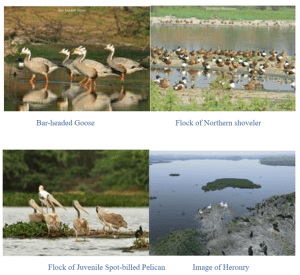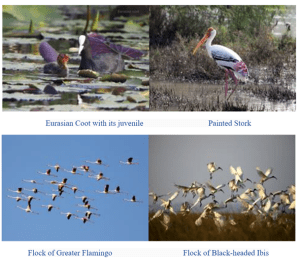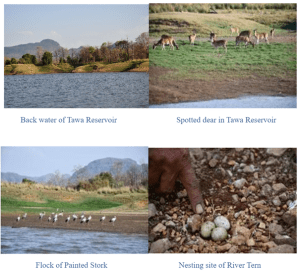TAG: GS 3: ECOLOGY AND ENVIRONMENT
THE CONTEXT: India has increased its tally of Ramsar sites (Wetlands of International Importance) to 85 from existing 82 by designating three more wetlands as Ramsar Sites.
EXPLANATION:
- With this addition, the area of Ramsar sites touched to 1358067.757 ha in the country.
- The three new sites included are Nanjarayan Bird Sanctuary and Kazhuveli Bird Sanctuary in Tamil Nadu and Tawa Reservoir in Madhya Pradesh.
- These new designated sites are a testament to the significant policy push from the Ministry of Environment, Forest and Climate Change for wetlands conservation and management in the country.
- India is one of the Contracting Parties to Ramsar Convention, signed in Ramsar, Iran, in 1971.
- India became a signatory to the convention on 1st February 1982.
- During 1982 to 2013, a total of 26 sites were added to the list of Ramsar sites, however, during 2014 to 2024, the country has added 59 new wetlands to the list of Ramsar sites.
- Currently, Tamil Nadu harbours maximum number of Ramsar Sites (18 sites) followed by Uttar Pradesh (10 sites).
Nanjarayan Bird Sanctuary:
- The Nanjarayan lake a large shallow wetland situated along the north-eastern region of Uthukuli Taluk of Tiruppur District in Tamil Nadu.
- The wetlands in this region depend mainly on weather conditions, especially on heavy rain water flow from Nallar drainage.
- Nanjarayan Lake is located on the Tiruppur -Uthukkuli main road about 10 km north of Tiruppur city in an area of 125.865 Ha near Sarkar Periyapalayam village in Tiruppur district.
- The lake falls under two villages (Sarkar Periyapalayam and Neruperichal). The lake got its name from the fact that it was repaired and restored by King Nanjarayan who was ruling the region many centuries ago.
- Further, about 191 species of birds, 87 species of butterflies, 7 species of amphibians, 21 species of reptiles, 11 species of small mammals and 77 species of plants have been recorded in and around the lake.
- The site acts as feeding and nesting habitat for resident bird species, migratory birds use this lake as their feeding ground during the migratory season.
- The lake also serves as important water source for agricultural purpose in the region. The lake plays vital role in ground water recharge.
- The lake is announced as 17th bird sanctuary of state of Tamil Nadu owing to its rich avifaunal diversity.
- The local community has already formed strong association in protecting the lake and its habitat. The forest department in collaboration with the local community manages the lake on sustainable basis.

Kazhuveli Bird Sanctuary
- The Kazhuveli Bird Sanctuary covering an area of 5151.6 ha was declared as the 16th bird sanctuary in Tamil Nadu in the year 2021.
- It is a brackish shallow lake located on the Coromandel Coast in Villupuram district, North of Pondicherry.
- The lake is connected to the Bay of Bengal by the brackish Uppukalli creek and the Edayanthittu Estuary.
- Kazhuveli is one of the significant and biodiversity rich wetlands.
- The lake is one of the largest wetlands in peninsular India.
- The lake can be divided into three parts based on the water features viz., the estuarine part with brackish water, the Uppukali creek feeding the sea water and the Kazuveli basin with fresh water.
- The Kazhuveli Bird Sanctuary lies in the Central Asian Flyway and is an important stopover site for migratory species of birds and breeding ground for resident species of birds, breeding ground for fish and serves as a major recharge source for the aquifers.
- In areas of brackish water highly degraded mangrove patches containing Avicennia species are found.
- In the earlier years, this area was reportedly harbouring Tropical Dry Evergreen Forests. In this area, reed (Typhaangustata) is found in several hundred hectares.

Tawa Reservoir
- The Tawa Reservoir has been constructed at the confluence of the Tawa and Denwa rivers.
- River Malani, Sonbhadra, and Nagdwari are the major tributaries of Tawa reservoir.
- Tawa River, a left bank tributary originates from Mahadeo hills in Chhindwara district, flows through Betul district and joins river Narmada in Narmadapuram district.
- It is the longest tributary of river Narmada (172 Km). Tawa Reservoir is situated near Itarsi town.
- The reservoir was built mainly for irrigation purpose. Although later on it is also being used for power generation and aquaculture.
- The total submergence area of Tawa reservoir is 20,050 hectares. The total catchment area of the reservoir is 598,290 hectares.
- Tawa reservoir comes under the administrative control of Forest department, district Narmadapuram.
- The reservoir is located inside the Satpura Tiger Reserve and forms the western boundary of the Satpura National Park and Bori Wildlife Sanctuary.
- Reservoir is important for aquatic flora and fauna especially birds and wild animals. Many rare and endangered species of plants, reptiles and insects are found here.
- It is an important habitat for many local and migratory birds. It is the largest protected area in the state Madhya Pradesh.
- The region is endowed with many unique features from ecological, archaeological, historical and forestry point of view.


